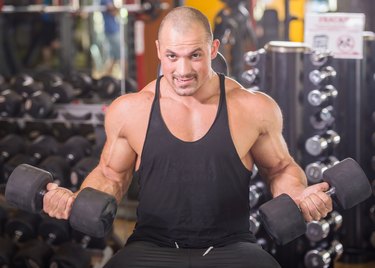
The biceps brachii and triceps brachii are the muscles of your upper arm. The biceps muscle is located on the front of your upper arm and is composed of two heads. The triceps makes up the back of your arm and is made up of three heads. Together, through a series of equal and opposite contractions, these muscles are responsible for flexion and extension of your elbow joint and contribute to functional movement.
Daily Movement
Video of the Day
Muscles close in proximity, such as the biceps and triceps, often work in groups to create functional movement. Functional movement is motion that contributes to your ability to complete the tasks and activities that form your daily life. Without coordination of muscle groups it would be difficult to stand, walk or lift objects.
Video of the Day
Agonist vs. Antagonist
Your biceps and triceps are examples of agonist and antagonist muscles. An agonist muscle is the primary mover. The primary mover is often responsible for initiating the major movement by a muscle shortening contraction. The antagonist muscle is a secondary mover. This muscle is responsible for contributing to the motion through a lengthening contraction, or stretch.
Motion Translation
To illustrate an example of an agonist–antagonist relationship and how it applies to your biceps and triceps muscles, imagine lifting a 10-lb. dumbbell. During the lifting phase, your biceps muscle is considered the agonist muscle. The biceps is engaged in a shortening contraction as it brings the weight closer to your arm. The triceps would be the antagonist muscle as it lengthens. Vice versa, during the lowering phase, the triceps muscle would be considered the agonist muscle, and the biceps would be the antagonist muscle.
Avoiding Injuries
Equal training of the muscles that make up the front of your body and the muscles that make up the posterior of your body is increasingly important as it helps to maintain a balance of strength between agonist and antagonist motions. Strength imbalances may make you more susceptible to injury as one muscle or group can overpower the opposing muscle and push it beyond its anatomical limits. To strengthen both muscle groups, the Centers for Disease Control and Prevention recommend that you complete eight to 10 resistance exercises that strengthen the major muscle groups of your body. These exercises should be completed for two to three sets of eight to 12 repetitions a minimum of two days per week. To ensure balance of the muscles, complete a pushing exercise for every pulling exercise.
- Physical Medicine and Rehabilitation Clinics of North America: Muscular Balance, Core Stability, and Injury Prevention for Middle- and Long-Distance Runners
- Centers for Disease Control and Prevention: How Much Physical Activity Do Adults Need?
- Loyola University Medical Education Network: Master Muscle List – Biceps Brachii
- Loyola University Medical Education Network: Master Muscle List – Triceps Brachii
Is this an emergency? If you are experiencing serious medical symptoms, please see the National Library of Medicine’s list of signs you need emergency medical attention or call 911.